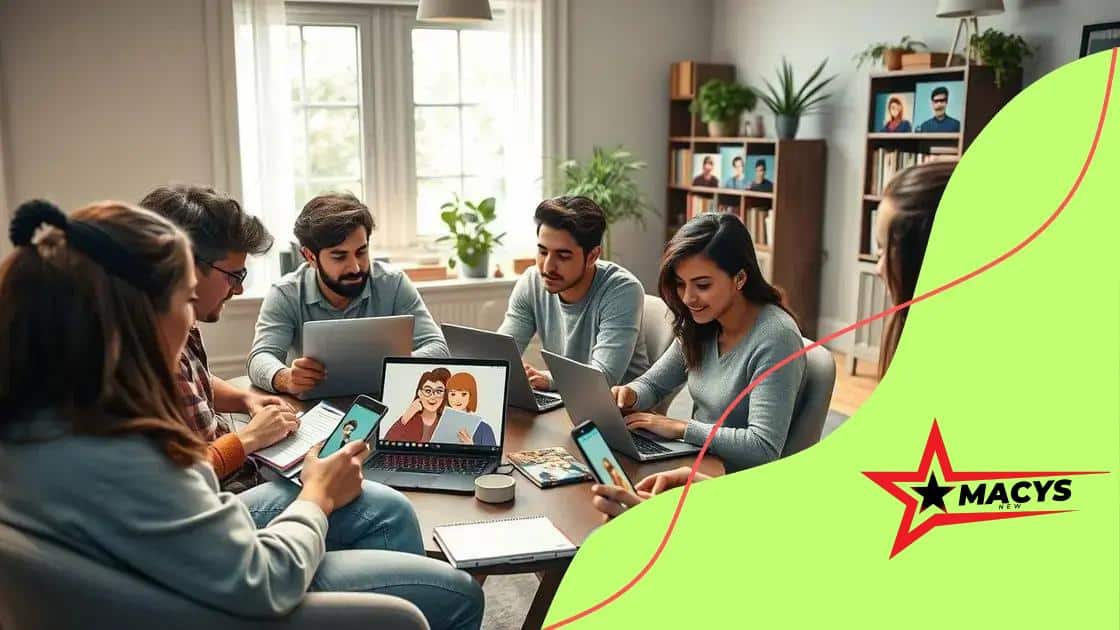Collaborative learning in virtual classrooms: a key to engagement

Collaborative learning in virtual classrooms enhances student engagement, communication, and critical thinking by using technology and interactive strategies, effectively addressing the challenges of remote education.
Collaborative learning in virtual classrooms is reshaping education by encouraging students to engage with each other actively. Have you ever wondered how this approach can benefit your learning experience? Let’s dive in!
Understanding collaborative learning
Understanding collaborative learning is essential in today’s educational landscape. This method emphasizes working together, allowing students to share knowledge and learn from one another.
Key Concepts of Collaborative Learning
It is important to recognize how collaboration affects the learning process. In essence, students engage in meaningful dialogue, which promotes deeper understanding. When they collaborate, they face challenges together, enhancing their problem-solving skills.
- Interaction leads to engagement.
- Diverse perspectives foster critical thinking.
- Accountability improves motivation.
Through collaborative learning, students can build social skills that are vital in any environment. Working together helps them develop empathy and respect for differing opinions. This practice not only supports academic success but also prepares learners for real-world scenarios.
Benefits of Understanding Collaborative Learning
Understanding the dynamics of collaborative learning can transform the educational experience. For instance, when students collaborate, they often explain concepts to each other, reinforcing their own learning as well. This approach makes lessons more engaging and enjoyable.
Furthermore, collaborative learning helps create a sense of community among students. They feel more connected to one another, and this connection can lead to lifelong friendships. As they learn to depend on each other, their confidence grows.
Strategies for Successful Collaboration
Incorporating collaborative learning in virtual classrooms requires thoughtful planning. Instructors can implement specific strategies to enhance the collaboration experience. Here are some effective methods:
- Use breakout rooms for group discussions.
- Assign roles to ensure active participation.
- Incorporate technology tools for shared projects.
By understanding and applying these strategies, educators can create an enriching learning environment that encourages collaboration. This leads to a more interactive and fulfilling educational journey for students.
Benefits of collaborative learning in virtual classrooms
The benefits of collaborative learning in virtual classrooms are significant. Students are not just passive learners; they become active participants in their education. By collaborating, they share insights and develop a deeper understanding of the material.
Enhanced Engagement
Collaborative learning fosters a higher level of engagement. When students work together, they become more motivated to participate. They feel a sense of responsibility toward their peers, which enhances their overall interest in learning.
- Active participation drives excitement.
- Peer support encourages risk-taking in learning.
- Real-time feedback from classmates helps clarify doubts.
Moreover, students are more likely to remember information when they discuss it with others. This social interaction is crucial for reinforcing knowledge and skills.
Development of Social Skills
Another key advantage of collaborative learning is the development of social skills. Students learn how to communicate effectively and share ideas. This interaction prepares them for real-world situations, where teamwork is often essential.
Collaboration helps students practice important skills such as listening, negotiating, and resolving conflicts. These skills are valuable not only in academic settings but also in future careers.
Diverse Perspectives
Collaborative learning also exposes students to diverse perspectives. Working with classmates from different backgrounds enriches discussions and challenges assumptions. As students learn to appreciate varied viewpoints, they enhance their critical thinking abilities.
This aspect of collaborative learning prepares students for a global society. They learn to respect and understand cultural differences, promoting inclusivity.
Improved Learning Outcomes
Finally, research shows that collaborative learning can lead to improved academic outcomes. Students retain information better and perform well on assessments when they study in groups. The synergy created during collaboration boosts their academic performance.
In summary, the benefits of collaborative learning in virtual classrooms are clear. These include enhanced engagement, social skills development, exposure to diverse perspectives, and improved learning outcomes. By leveraging these benefits, educators can create dynamic and effective learning environments.
Effective strategies for fostering collaboration

Effective strategies for fostering collaboration in virtual classrooms can transform the learning experience for students. Implementing thoughtful techniques encourages teamwork and enhances communication skills.
Create Group Roles
Assigning specific roles within groups can help students take ownership of their tasks. By having designated responsibilities, each student can contribute uniquely to the group’s success. This strategy not only promotes active participation but also clarifies expectations.
- Leader: Guides discussions and keeps the group on track.
- Note-taker: Records important points and decisions.
- Presenter: Shares the group’s findings with the class.
Encouraging students to switch roles regularly can further enhance their learning experience, promoting a well-rounded skill set.
Utilize Technology Tools
Integrating technology can greatly enhance collaboration in virtual classrooms. Tools such as video conferencing and shared documents facilitate real-time communication and project management. Students can easily brainstorm and provide feedback on each other’s ideas from anywhere.
Some popular tools include:
- Google Docs: For collaborative writing and editing.
- Padlet: For brainstorming and sharing resources.
- Trello: For project management and organization.
These tools allow students to work together efficiently and stay engaged in the learning process.
Incorporate Group Projects
Group projects are one of the best ways to foster collaboration. By working together towards a common goal, students can apply what they have learned and support each other throughout the process. This hands-on approach helps them build teamwork skills and gives them opportunities to learn from their peers.
To maximize effectiveness, projects should be clearly defined and include specific objectives. Setting milestones can help groups manage their time and track progress effectively.
Encourage Reflection
After collaborative activities, prompting students to reflect on their experiences can provide valuable insights. Encouraging them to discuss what worked well and what challenges they faced cultivates a growth mindset.
Reflection can be facilitated through:
- Group discussions about their group dynamics.
- Journals to express thoughts on the collaborative process.
- Feedback forms to evaluate individual contributions.
By understanding their experiences, students can identify areas for improvement, making future collaborations even more successful.
Tools that enhance virtual collaboration
Tools that enhance virtual collaboration play a crucial role in creating effective learning environments. With the rise of online education, having the right tools is essential for student success. When used effectively, these tools can bridge the gap between students and facilitate meaningful interactions.
Video Conferencing Platforms
Video conferencing platforms are at the heart of virtual collaboration. They enable real-time communication, allowing students to interact just like they would in a physical classroom. Popular options include:
- Zoom: Known for its reliability, it supports large groups and offers breakout rooms for smaller discussions.
- Microsoft Teams: Integrates well with Office 365, allowing document sharing and collaboration during meetings.
- Google Meet: A user-friendly option that seamlessly connects with Google Workspace applications.
These platforms help maintain the social aspect of learning, which is key for engagement.
Collaborative Document Editing
Collaborative document editing tools allow students to work together on projects in real time. These tools provide the ability to edit documents simultaneously, which enhances teamwork. Notable options are:
- Google Docs: Enables multiple users to write, edit, and comment on documents instantaneously.
- Microsoft Word Online: Offers similar features within the familiar Word interface.
- Quip: Combines documents and spreadsheets with chat, making collaboration efficient.
Through these tools, students can share ideas quickly and receive instant feedback.
Project Management Applications
Project management applications assist students in organizing their tasks and deadlines. These tools improve accountability and help students manage their time effectively. Key tools include:
- Trello: Uses boards and cards to track tasks and facilitate organization.
- Asana: Enables teams to assign tasks, set deadlines, and monitor progress in one place.
- Monday.com: Offers customizable workflows for various project types.
By using these applications, students can keep their group projects on track and visually see their progress.
Discussion Forums and Online Boards
Discussion forums and online boards enhance communication outside of scheduled meetings. These platforms allow for asynchronous communication, where students can share their thoughts and resources at their convenience. Popular tools include:
- Slack: A messaging platform that enables group chats, file sharing, and integrations with other tools.
- Padlet: An interactive board for sharing ideas and comments, making it easy to collaborate on topics visually.
- Edmodo: Focused on education, it provides a safe space for students and teachers to share assignments and collaborate.
Using discussion forums encourages student interaction and broadens their perspectives.
Challenges and solutions in virtual classrooms
Challenges and solutions in virtual classrooms are critical topics to explore. As education moves online, both students and educators face unique obstacles. Understanding these challenges helps in finding effective solutions.
Technology Issues
One major challenge in virtual classrooms is technology-related issues. Connectivity problems can disrupt lessons and hinder participation. Students with limited access to reliable internet may struggle to keep up with their peers.
- Poor internet connections: Slow speeds can make video calls difficult.
- Device availability: Some students may lack access to necessary devices, like computers or tablets.
- Software familiarity: Not all students are comfortable using new tools or applications.
To resolve these issues, schools can provide resources such as laptops or internet hotspots. Offering training sessions on how to use software effectively can also enhance students’ experiences.
Engagement and Motivation
Another significant challenge is maintaining student engagement and motivation. In a virtual setting, distractions abound, making it easy for students to lose focus.
Strategies to foster engagement include:
- Interactive activities: Incorporating games or quizzes promotes active participation.
- Regular check-ins: Brief one-on-one meetings can help educators gauge student progress and difficulties.
- Peer collaboration: Group projects encourage communication and accountability among students.
By making lessons more engaging, educators can help students stay motivated and interested in their studies.
Communication Challenges
Effective communication is vital in any learning environment. In virtual classrooms, misunderstandings can arise due to the absence of nonverbal cues. Students may feel disconnected without face-to-face interactions.
To enhance communication, teachers can:
- Utilize video calls: Face-to-face interactions create a more personal connection.
- Encourage discussions: Facilitate open dialogues in chat or forums for students to voice their thoughts.
- Provide clear instructions: Clear guidelines on assignments and expectations can mitigate confusion.
These strategies can lead to clearer and more effective communication between students and educators.
Time Management
Time management is another struggle for students in virtual classrooms. Without a structured environment, they may find it challenging to balance their studies with personal responsibilities.
To help students manage their time effectively, teachers can recommend:
- Creating schedules: Encouraging students to set daily or weekly schedules can help them stay organized.
- Setting deadlines: Assigning clear deadlines for tasks can create a sense of urgency.
- Time management tools: Suggesting apps or calendars that help track assignments and deadlines can improve their organization.
By implementing these measures, students can develop better time management skills, leading to increased productivity.
FAQ – Frequently Asked Questions about Collaborative Learning in Virtual Classrooms
What are the main challenges of virtual classrooms?
The main challenges include technology issues, maintaining student engagement, communication difficulties, and time management.
How can technology improve virtual collaboration?
Technology enhances virtual collaboration by providing tools for video conferencing, collaborative document editing, and project management.
What strategies can improve student engagement in virtual classes?
Effective strategies include using interactive activities, incorporating group projects, and having regular check-ins with students.
How can students manage their time effectively in virtual classrooms?
Students can manage their time by creating schedules, setting clear deadlines, and using time management tools to track their assignments.





